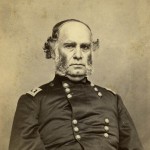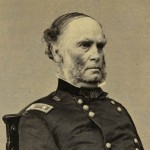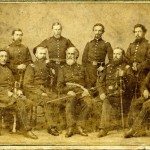Samuel Ryan Curtis was born on February 3, 1805, near Champlain, New York, but grew up in central Ohio and attended the U. S. Military Academy, graduating twenty-seventh in a class of thirty-three in 1831. After a year of service, he resigned his commission and returned to Ohio to begin a successful engineering career.
During the Mexican-American War, Curtis mustered Ohio troops into service and commanded the 3rd Ohio Infantry. Moving to Iowa in 1853, he was elected to Congress in 1856 and was narrowly re-elected in 1858 and 1860. After the attack on Fort Sumter, Curtis equipped and mustered Iowa’s first volunteer regiments, and was unanimously elected colonel of the 2nd Iowa Infantry. He resigned from Congress in August 1861 to accept promotion to brigadier general.
In December 1861 Curtis was ordered to remove organized Confederate resistance from southwest Missouri. On March 7, 1862, General Earl Van Dorn with 16,000 Confederate troops attacked Curtis’s army of 10,500 entrenched near Pea Ridge, Arkansas. Although surprised by two fierce attacks, Curtis quickly reversed his front and after two days of heavy fighting the Confederate army withdrew. Curtis’s victory at Pea Ridge saved Missouri for the Union.
Promoted to major general, Curtis assumed command of the Department of the Missouri, but ran afoul of Missouri Governor Hamilton Gamble and was reassigned in May 1863.
Taking command of the Department of Kansas in January 1864, Curtis faced a new threat that October, when Confederate General Sterling Price’s invasion of Missouri turned toward Kansas. Curtis tried unsuccessfully to stop Price at the Big Blue River, but decisively defeated him at the Battle of Westport. Price retreated south with Curtis in pursuit.
After the war Curtis helped negotiate a settlement with the Sioux and became a commissioner for the transcontinental railroad.
Curtis died suddenly on December 26, 1866, in Council Bluffs, Iowa, possibly from heart disease.






